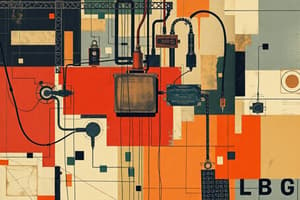Podcast
Questions and Answers
What are the elements of a measurement system?
What are the elements of a measurement system?
- a sensor, 2. a signal conditioner, 3. a display system
What is a sensor?
What is a sensor?
A sensor produces a signal related to the quantity being measured.
What are the differences between an open and closed loop system, and what are their advantages?
What are the differences between an open and closed loop system, and what are their advantages?
Open loop: input does not depend on an output (advantage is that it is low cost and simple). Closed loop: output compared to input (offer superior accuracy and adaptability by incorporating feedback).
What does a potentiometer sensor measure?
What does a potentiometer sensor measure?
What is a strain-gauged element?
What is a strain-gauged element?
What do differential transformers do?
What do differential transformers do?
What are pneumatic sensors used for and what is the typical ranges?
What are pneumatic sensors used for and what is the typical ranges?
What is a microswitch?
What is a microswitch?
What is a reed switch used for?
What is a reed switch used for?
How can photosensitive devices be used?
How can photosensitive devices be used?
What is a strain gauge load cell used for?
What is a strain gauge load cell used for?
What are Piezoelectric sensors used for?
What are Piezoelectric sensors used for?
What does a tactile sensor measure?
What does a tactile sensor measure?
What can we measure fluid pressure with?
What can we measure fluid pressure with?
Why do we need signal conditioning?
Why do we need signal conditioning?
What is the ideal electrical impedance conditions for measuring and for maximizing power transfer?
What is the ideal electrical impedance conditions for measuring and for maximizing power transfer?
When would we use a wheatstone bridge?
When would we use a wheatstone bridge?
How are analog signals sampled for ADC?
How are analog signals sampled for ADC?
What do Actuation systems do?
What do Actuation systems do?
What are Valves used for?
What are Valves used for?
What are Cylinders: Linear actuators?
What are Cylinders: Linear actuators?
What is the purpose/use for basic mechanisms?
What is the purpose/use for basic mechanisms?
Describe the role of an actuation system?
Describe the role of an actuation system?
Describe the operation of force sensing resistor
Describe the operation of force sensing resistor
What is the operation of an optical encoder?
What is the operation of an optical encoder?
Describe a method to protect a microcontroller from both high voltage and wrong polarity
Describe a method to protect a microcontroller from both high voltage and wrong polarity
Explain the role of gear trains and the similarities between gear trains and belt drive
Explain the role of gear trains and the similarities between gear trains and belt drive
What is the minimum number of bits required to have resolution 0.5 psi or better given a pressure sensor with range 0-100 psi and sensitivity 30 mV/psi?
What is the minimum number of bits required to have resolution 0.5 psi or better given a pressure sensor with range 0-100 psi and sensitivity 30 mV/psi?
What is the resolution of an Arduino ADC that includes 10 bits and range 0 V to 5 V?
What is the resolution of an Arduino ADC that includes 10 bits and range 0 V to 5 V?
For the same Arduino as question 4, what is the input voltage if analogRead outputs 354?
For the same Arduino as question 4, what is the input voltage if analogRead outputs 354?
What is the minimum number of bits required to have a resolution of 0.1 N or better given a force sensor with range 0-200 N corresponding to output voltages of 0-10 V?
What is the minimum number of bits required to have a resolution of 0.1 N or better given a force sensor with range 0-200 N corresponding to output voltages of 0-10 V?
What is an actuation system? Give an example
What is an actuation system? Give an example
What are some parallels/analogous components between the pneumatic and hydraulic actuation systems?
What are some parallels/analogous components between the pneumatic and hydraulic actuation systems?
What is the key difference between bipolar transistors and MOSFETs?
What is the key difference between bipolar transistors and MOSFETs?
Explain the operation of a solenoid and how it may be used to control a pneumatic cylinder
Explain the operation of a solenoid and how it may be used to control a pneumatic cylinder
What is the purpose of the 'brushes' in a brush-type DC motor?
What is the purpose of the 'brushes' in a brush-type DC motor?
What are the relative advantages/disadvantages of DC compared to AC motors?
What are the relative advantages/disadvantages of DC compared to AC motors?
Is the torque of a DC motor proportional to voltage or current?
Is the torque of a DC motor proportional to voltage or current?
Describe a circuit that can control the velocity of a DC motor using a constant power supply.
Describe a circuit that can control the velocity of a DC motor using a constant power supply.
What is the output of a Wheatstone bridge with one strain gauge if the nominal resistance of the gauge and all other resistors is 120 $\Omega$, gauge factor is 2.1, and strain is 3$\times$10^-5. The bridge source voltage is 5 V. Assume the change in resistance of the gauge is much less than 120 $\Omega$
What is the output of a Wheatstone bridge with one strain gauge if the nominal resistance of the gauge and all other resistors is 120 $\Omega$, gauge factor is 2.1, and strain is 3$\times$10^-5. The bridge source voltage is 5 V. Assume the change in resistance of the gauge is much less than 120 $\Omega$
Given the op-amp circuit diagram and IC diagram above, sketch the output signal if the input signal is one cycle of a 1 Hz sinusoid with amplitude 0.5 V. The resistor values are Rf = 20 k$\Omega$ and Rin = 1 k$\Omega$. Pin 7 of the IC is connected to +5 V and pin 4 is connected to ground
Given the op-amp circuit diagram and IC diagram above, sketch the output signal if the input signal is one cycle of a 1 Hz sinusoid with amplitude 0.5 V. The resistor values are Rf = 20 k$\Omega$ and Rin = 1 k$\Omega$. Pin 7 of the IC is connected to +5 V and pin 4 is connected to ground
Identify one advantage and one disadvantage of active filters compared to passive filters
Identify one advantage and one disadvantage of active filters compared to passive filters
Describe the operation of a variable reluctance tachogenerator
Describe the operation of a variable reluctance tachogenerator
Flashcards
What is a sensor?
What is a sensor?
A system that produces a signal related to the quantity being measured.
Open Loop System
Open Loop System
Input is independent of output; simple and low cost.
Closed Loop System
Closed Loop System
Output is compared to input, enabling adaptability and accuracy.
Potentiometer Sensor
Potentiometer Sensor
Signup and view all the flashcards
Strain Gauge
Strain Gauge
Signup and view all the flashcards
Differential Transformer
Differential Transformer
Signup and view all the flashcards
Microswitch
Microswitch
Signup and view all the flashcards
Photosensitive Device
Photosensitive Device
Signup and view all the flashcards
Strain Gauge Load Cell
Strain Gauge Load Cell
Signup and view all the flashcards
Piezoelectric Sensor
Piezoelectric Sensor
Signup and view all the flashcards
Tactile Sensor
Tactile Sensor
Signup and view all the flashcards
Why signal conditioning?
Why signal conditioning?
Signup and view all the flashcards
Ideal Impedance Conditions
Ideal Impedance Conditions
Signup and view all the flashcards
Wheatstone Bridge
Wheatstone Bridge
Signup and view all the flashcards
Analog Signal Sampling
Analog Signal Sampling
Signup and view all the flashcards
Actuation System
Actuation System
Signup and view all the flashcards
Valves
Valves
Signup and view all the flashcards
Cylinders: Linear Actuators
Cylinders: Linear Actuators
Signup and view all the flashcards
Purpose of Basic Mechanisms
Purpose of Basic Mechanisms
Signup and view all the flashcards
Role of Actuation System
Role of Actuation System
Signup and view all the flashcards
Force Sensing Resistor
Force Sensing Resistor
Signup and view all the flashcards
Optical Encoder
Optical Encoder
Signup and view all the flashcards
Zener Diode
Zener Diode
Signup and view all the flashcards
Solenoid
Solenoid
Signup and view all the flashcards
Gear Trains
Gear Trains
Signup and view all the flashcards
Bipolar vs MOSFET
Bipolar vs MOSFET
Signup and view all the flashcards
Solenoid Operational
Solenoid Operational
Signup and view all the flashcards
Brushes for DC motors
Brushes for DC motors
Signup and view all the flashcards
DC motor's torque
DC motor's torque
Signup and view all the flashcards
DC vs AC motor
DC vs AC motor
Signup and view all the flashcards
Study Notes
- These are flashcard definitions relating to Mechatronics Exam 1
Measurement System Elements
- The elements consist of a sensor, a signal conditioner, and a display system.
Sensor Function
- A sensor generates a signal that corresponds to the measured quantity.
Open Loop Systems
- Input is independent of output.
- Advantages: low cost and simplicity.
Closed Loop Systems
- Output is compared to input, incorporating feedback.
- Advantages: superior accuracy and adaptability.
Potentiometer Sensors
- Measure linear or rotary displacement.
- Converts displacement into an electrical signal.
Strain-Gauged Element
- Resistance changes with applied force.
- Converts force, pressure, tension, weight, into changes in electrical resistance.
Differential Transformers
- Converts linear motion into an electrical signal.
Pneumatic Sensors
- Measures small displacements, typically in the range of 3 to 12 mm.
Microswitch
- A small electrical switch.
- Requires physical contact and a small operating force to close contacts.
Reed Switch
- Used for checking door closures and in devices like tachometers for counting turns.
Photosensitive Devices
- Detect the presence of opaque objects by beam interruption or reflection.
Strain Gauge Load Cell
- Measures force by monitoring strain in a member using electrical resistance strain gauges.
Piezoelectric Sensors
- Used for measuring pressure, force, and acceleration.
Tactile Sensor
- Indicates physical contact between two objects.
Fluid Pressure Measurement
- Mechanical methods include U-tube manometers, Bourdon tubes, and diaphragms/bellows.
- Electrical methods include strain gauges, capacitive sensors, potentiometric, resonant wire, piezoelectric, magnetic, and optical sensors.
Signal Conditioning
- Protects subsequent elements with fuses and diodes.
- Converts signals into the correct format (e.g., resistance to voltage).
- Adjusts signal levels for optimal readability.
- Reduces noise using filters.
- Signal manipulation, using pulses to get a constant value to overcome drift.
Electrical Impedance Considerations
- For measuring, the meter resistance should be much greater than the sensor resistance (Rmeas >> Rsensor).
- For maximizing power transfer, impedance matching is needed (Rsource = Rload).
Wheatstone Bridge
- Used with strain gauges.
Analog Signal Sampling for ADC
- Converts digital representations to analog via a DAC.
- Compares with the analog signal to find the smallest digital value where the analog signal is greater.
Actuation Systems
- Transform microprocessor or control system outputs into controlling actions on devices or machines.
Valves
- Direct and regulate fluid flow in hydraulic and pneumatic systems.
Cylinders: Linear Actuators
- Cylindrical tubes with a sliding piston or ram.
- Types: single-acting (spring return) and double-acting.
Basic Mechanisms
- Force amplification using levers.
- Change of speed/torque using gears.
- Transfer of rotation between axes, e.g., timing belts.
- Specialized motion using quick-return mechanisms.
Role of Actuation System
- Converts a control signal into a physical action or motion to control the system.
Force Sensing Resistor (FSR)
- Resistance changes based on applied force.
- Typical signal conditioning: voltage divider.
Optical Encoder
- Measures angular displacement, which allows calculation of displacement.
- Evenly spaced holes determine displacement based on counts.
Microcontroller Protection
- Zener diodes protect against high voltage and reverse polarity.
Solenoid
- A coil of wire carrying current to produce a magnetic field.
Gear Trains and Belt Drives
- Both control angular velocity.
- Gear trains use rotational force between gears.
- Belt drives use belts and wheels, allowing for different wheel sizes.
Resolution Calculation Example 1
- Problem: Find the minimum bits for 0.5 psi resolution with a 0-100 psi sensor and 30 mV/psi sensitivity.
- Steps: Convert pressure resolution to voltage resolution, then calculate the number of bits using log base 2.
- Answer: 8 bits are needed.
Resolution Calculation Example 2
- Problem: Determine the resolution of a 10-bit Arduino ADC with a 0-5V range.
- Steps: Divide the voltage range by the number of steps (2^10).
- Answer: Resolution is 0.0049 V.
Analog Input Voltage
- Steps: The formula to determine the voltage is: (reading / 1023) * 5 V.
- Calculation: Using a reading of AnalogRead outputting 354, the voltage calculated is 1.73 V.
Resolution Calculation Example 3
- Problem: Find the minimum bits for 0.1 N resolution with a 0-200 N force sensor corresponding to 0-10 V output.
- Steps: Calculate using Res = max value/2^n and solve for n.
- Answer: 11 bits are needed.
Actuation System
- Takes a controlling action, imparting a change on the rest of the system.
- Involves a significant change in energy.
- Converts an electrical signal to a linear motion using a solenoid valve and a pneumatic cylinder.
Pneumatic and Hydraulic Systems
- Both include a power supply, valve control, and cylinder actuation.
- Power supplies include compressors (pneumatic) and pumps (hydraulic) to pressurize the fluid.
- Additional components are analogous to signal conditioning in electrical circuits.
Bipolar Transistors vs. MOSFETs
- Bipolar transistors are controlled by current whereas MOSFETs are voltage controlled.
Solenoid Operation
- Applying current to a coil produces a magnetic field, moving a metal armature.
- Used to control valves, such as spool valves, to control pneumatic cylinder pressure.
Brushes in DC Motors
- Rotate with the rotor.
- Contact the voltage source.
- Allow current flow in the armature coil.
- Periodically switch contacts to reverse current, ensuring continuous rotation in intended direction.
DC vs. AC Motors
- AC motors are cheaper, rugged, reliable, and maintenance-free.
- DC motors are easier to control the speed.
DC Motor Torque
- Torque is proportional to current.
DC Motor Velocity Control
- Pulse width modulation (PWM) to control effective voltage.
- MOSFET switching.
- H-bridge circuit for direction control.
Wheatstone Bridge Output
- Given: Nominal resistance = 120 Ω, gauge factor = 2.1, strain = 3×10-5, source voltage = 5 V.
- Formula = Vs * dR / (R1+R2) = Vs *G * strain / 2.
- Output voltage = 0.1575 mV.
Op-Amp Circuit
- Inverting amplifier configuration.
- Calculation: Vout / Vin = -Rf / Rin.
- Saturation: Output signal is clipped at ground and +5 volts.
Active Filter
- Advantage: unaffected by downstream impedance.
- Disadvantage: requires a power source.
Variable Reluctance Tachogenerator
- Toothed wheel attached to rotating shaft.
- Stationary pick-up coil wound around a permanent magnet.
- Alternating flux creates an alternating emf with a frequency correlating to shaft angular frequency.
Studying That Suits You
Use AI to generate personalized quizzes and flashcards to suit your learning preferences.




